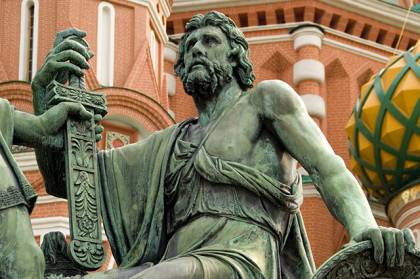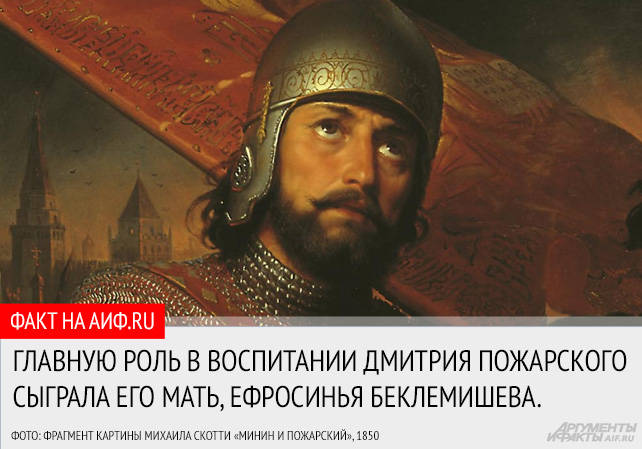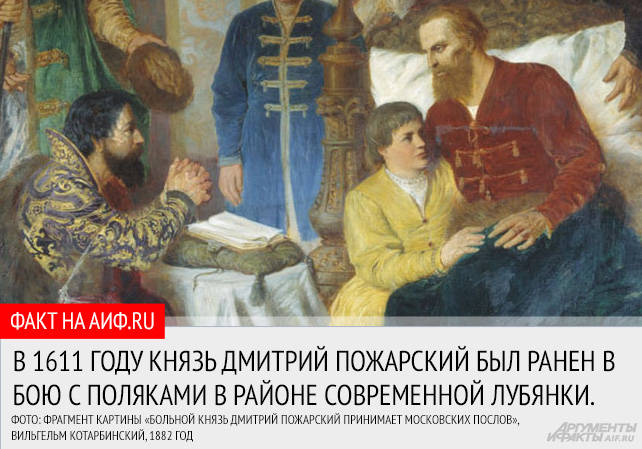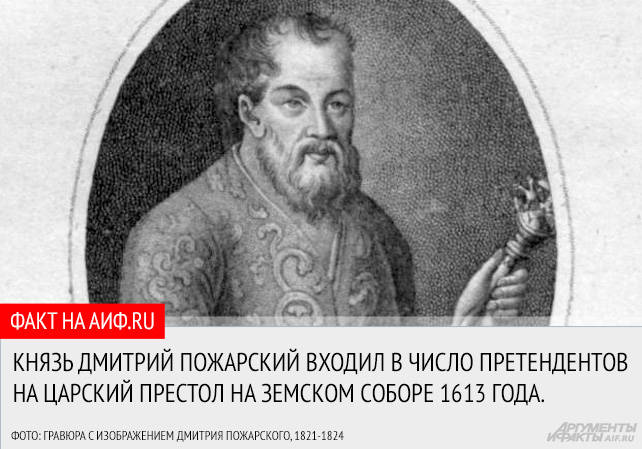Knight's story. As prince Pozharsky saved Russia and did not become king
 Prince Dmitry Mikhailovich Pozharsky was distinguished by courage, courage, intelligence, loyalty to the word and unselfishness. These qualities glorified him for centuries, but prevented him from taking the throne.
Prince Dmitry Mikhailovich Pozharsky was distinguished by courage, courage, intelligence, loyalty to the word and unselfishness. These qualities glorified him for centuries, but prevented him from taking the throne.Hero raised mother
The era of the Time of Troubles was the hardest test for Russia. The question was not only about power, but about the very existence of the country as an independent state.
Internal civil strife has shaken all state institutions, all perceptions of duty and honor. Many statesmen during this period managed to change camps repeatedly, supporting one or the other contenders for the throne. In a word, there are almost no those who did not mess with their name with shameful acts.
“Almost” - because among the heroes of the Time of Troubles, the figure of Prince Dmitry Mikhailovich Pozharsky stands apart, with courage, whose valor and loyalty to the oath were admired not only by comrades, but also by enemies.
The future hero was born on November 1 of 1578 in the family of Prince Mikhail Fedorovich Pozharsky and Euphrosyne Feodorovna Beklemisheva.
Rod princes Pozharsky leads his history from the legendary Prince Vsevolod the Big Nest, whose descendants ruled Russia right up to the suppression of the Rurik dynasty.
Despite this, in the era of Ivan the Terrible, Dmitriy’s father was not in the public service. Generally, in the Pozharsky family there were no prominent commanders and politicians. Is that Dmitry's grandfather, Fedor Ivanovich Pozharsky, was a regimental commander of Ivan the Terrible during the capture of Kazan.
Dmitry Pozharsky's father died when the boy was not even ten years old. Mother moved Dmitry with her brother and sister to Moscow, where she took up their upbringing.

Euphrosyne Beklemisheva came from a noble noble family, but even with this in mind for her time she was a unique woman. The mother of Prince Dmitry herself received an excellent education and was able to give the same to her children. Throughout her life, she helped Dmitry with wise advice, to which her son always listened.
It was the mother who formed such qualities as the absence of arrogance, arrogance and conceit in Dmitry Pozharsky; lack of greed and arrogance, justice and generosity; modesty and honesty in dealing with people and actions; dedication to the sovereigns of Russia and their Fatherland; courage and self-sacrifice.
Atypical career
In 1593, 15-year-old Dmitry Pozharsky enters the royal service. To the accession of Boris Godunov, the prince wore court title "Solicitor with a dress." The prince's mother also occupied a fairly high position at court, although the position of Pozharsky until the 1602 year remained unstable. The new monarch, apparently, groped those people on whom he could rely. In 1602, 24-year-old Dmitry Pozharsky, who proved to be a good enough service, received the rank of steward from the king.
However, with the instability of supreme power, the elevation could be short-lived. And indeed, in the 1605 year, Boris Godunov died, and False Dmitry I. solemnly entered Moscow.
However, the young Prince Pozharsky remained at the court. Loyalty to duty by that time became the distinguishing feature of Dmitry. But the False Dmitry in Moscow was recognized as the legitimate king, and Prince Pozharsky did not allow himself to doubt his “legitimacy”.
But in 1606, the struggle for the throne continued - the False Dmitry was overthrown and killed, and the boyar Vasily Shuisky ascended to the throne. The new tsar was sworn in by his subjects, and Dmitry Pozharsky among them.
The power of Vasily Shuisky was weak - the army of the new impostor False Dmitry II, nicknamed “Tushinsky Thief”, was advancing to the very walls of Moscow; Lithuanians and Poles were in charge of looting and ruining cities in western Russia, armed gangs everywhere.
Vasily Shuisky needed skilled and loyal generals, and in 1608, he appointed 30-year-old Dmitry Pozharsky as a regimental voivode.
The new commander immediately showed himself brilliantly, breaking the squad "Tushinsky thief" near Kolomna. A year later, he noted that he had completely defeated the gangs of the rebellious ataman Salkov, after which in February 1610 he was appointed governor to the city of Zaraysk.
Shuisky noted the talented commander, having presented the village of Nizhny Landekh and the landlord Kholui in Suzdal district with villages, repairs and wastelands to him as patrimony.
In 1610, another talented Russian military commander, Mikhail Skopin-Shuisky, with the Russian-Swedish army, liberated the outskirts of Moscow from the troops of the Tushino Thief and the Polish-Lithuanian gangs. However, after this success Skopin-Shuisky was poisoned. The death of the commander was associated with the name of his uncle - Tsar Vasily Shuisky, who began to fear the popularity of his nephew.
The death of Skopin-Shuisky caused a great outrage among the people. Part of the Russian cities refused to further recognize the authority of Vasily Shuisky. Zaraysk also hesitated, but the authority of the governor of Pozharsky, who remained loyal to the oath, allowed the city to remain under the control of the royal authority.
Fearless warrior
But Vasily Shuisky, Prince of Pozharsky, did not save loyalty - he was overthrown by the boyars, forcibly tonsured as a monk, and then sent to Polish captivity, where he soon died.
In Russia, the final chaos. In Moscow, the functions of the government were performed by the so-called “Seven Boyarschina”, advocating the invitation to the throne of the Polish king Vladislav. At the same time, the current Polish king, Sigismund III, claimed the throne. Part of the cities of Russia was controlled by the troops of the next False Dmitry. In addition, various small, militarized groups that did not submit to anyone flourished everywhere.
The whole question raised the question whether Russia will continue to exist as a state.
Polish troops entered Moscow with whom the representatives of the Seven Boyars collaborated. Patriarch Hermogenes called for resistance to the invaders, who sent letters to all cities of Russia with a call to protect the Russian land and the Orthodox faith.
One of the most active activists of the First Militia, which was formed for the liberation of Moscow in 1611, was Ryazan voivode Procopius Lyapunov. It was to the Lyapunov detachment with his warriors that the Zaraisk voivode Dmitry Pozharsky joined.

The first militia turned out quite mixed and poorly organized. He was led by a triumvirate of Procopius Lyapunov, Prince Dmitry Trubetskoy and Ataman Ivan Zarutsky. The Cossacks of the latter for a long time were part of the troops of the Tushino Thief. Distrust and conflicts among the leadership of the militia led to his failure. The troops managed to approach Moscow and even capture the White City, but more could not be achieved. The conflict between Zarutsky and Prokopiy Lyapunov ended in the murder of the latter, after which the militia disintegrated.
As for Prince Dmitry Pozharsky, he did not participate in these feuds and proved himself from the best side. In May, 1611, he heroically fought with the Poles on the streets of Moscow, reflecting their attacks in the area of modern Lubyanka. Stop it could only serious injury. Companions were taken by the prince from Moscow to the Trinity-Sergius monastery, and then transported for treatment to the family estate of Yurino Nizhny Novgorod district.
The best tandem
In September, 1611, an energetic and active Nizhny Novgorod district warden Kozma Minin called for the formation of a new militia for the liberation of Moscow and Russia and in general.
Minin was supported and entrusted to him to lead the collection of funds and their distribution among the warriors of the future militia.
Given the bitter experience of the first militia, Kozma Minin seriously approached the issue of the candidacy of a military commander. However, in the eyes of many, Dmitry Pozharsky seemed to have no alternative candidate. He was almost the only one who managed not to get dirty in all sorts of betrayals and bloody internecine clashes. His victories and wounds received in battle spoke of military prowess.
As a result, the citizens of Nizhny Novgorod called for the leadership of Dmitry Pozharsky's militia. He accepted the invitation, but on condition that Kozma Minin was in charge of all the economic matters in the militia, the organizing ability of which the prince was able to appreciate.
This is how the Pozharsky-Minin tandem was formed, which became one of the most successful in the history of Russia.
The new militia did not immediately move to Moscow. Having solved organizational issues, it formed the “Council of All Lands”, which became, in fact, the new Russian government, an alternative to the “Seven Boyars”.
Gradually, the new structure began to restore order in the field, eliminating powerlessness and restoring stability. At the same time, the militia received new funding and fighters.
The actions of the government headed by Pozharsky and Minin inspired hope to Russians tired of the Troubles.
The Liberator is too good for a king
At the end of July, 1612, the Second Militia fought on Moscow. The militiamen went to intercept the troops of the Polish hetman Chodkiewicz, who was moving to help the Poles in Moscow with a large wagon train. The fact is that since the time of the First Militia part of the Russian troops continued to block the Polish garrison in the Kremlin.
The battle at the walls of Moscow between the 15-thousandth army of Hetman Khodkevich and 8000 of Prince Dmitry Pozharsky's militia stretched for several days. The courage of the Russian soldiers and the leadership talent of Prince Pozharsky solved the matter - the hetman's troops suffered a decisive defeat and retreated.

The occupiers remaining in the Kremlin were deprived of any hope for help. 1 November 1612, after a long siege, the militia stormed China Town. Four days later, the Kremlin garrisoned surrendered. Moscow was liberated from invaders.
The government of Pozharsky and Minin fulfilled his task, and the new tsar was to be elected by a specially convened Zemsky Sobor, which began to meet in January of 1613.
Among the candidates for the vacant throne was the name of Prince Dmitry Pozharsky.
From the point of view of the common people, he was the perfect option. The prince, who has not stained himself by meanness, betrayal and theft, has glorified his name with military prowess, has saved the country from invaders - what kind of a king is needed?
But the logic of the people and the elite in all ages differed significantly. From the point of view of the nobility, Prince Pozharsky was too distantly related to the Rurikovichs, he was not listed as a Trouble in the front ranks of the boyars. But the main thing that frightened the powers that be was the impeccable reputation of Dmitry Pozharsky. The representatives of the Russian elite, who were completely upset by the crimes during the Time of Troubles, were afraid of retaliation. It is easier to write off and forget all crimes if the one who has the stigma of a cannon is on the throne.
It is clear that the 17-year-old Mikhail Romanov himself elected to the kingdom did not have time to be noted for crimes during the Time of Troubles, but the Romanovs as a whole got pretty dirty. However, this is a topic for another conversation.
Prince of Emergencies
Prince Dmitry Pozharsky with the new king did not fall into disgrace, but, on the contrary, became one of the most prominent figures of the new era.
A new dynasty needed an experienced, and most importantly, loyal oath man, on whom it was possible to rely. It was impossible to find a person more reliable than Prince Pozharsky.
He repulsed new attacks by Polish detachments, led diplomatic negotiations, led Yamskoy and Rogue orders in different years, was the Novgorod commander and viceroy in Suzdal, then headed the Moscow Judgment. Looking at the career of Prince Pozharsky under Mikhail Romanov, we can say that for the tsar he became the same as Sergei Shoigu for Vladimir Putin. Dmitry Pozharsky was constantly charged with the most problematic and difficult state issues.
Dmitry Mikhailovich Pozharsky died April 30 of the year 1642. For a long time, the hero’s burial place remained a secret. It was only in the second half of the 19th century that it was established for certain that Prince Dmitry Pozharsky was buried in the ancestral tomb in the Suzdal Savior Euthymius monastery. Over the years, the tomb was destroyed and was finally dismantled in 1933 year. However, the prince’s grave itself was intact. In 2009, the tomb was restored and opened on November 4 in the presence of Russian President Dmitry Medvedev.
Information